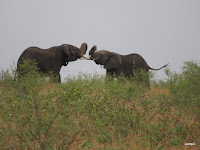 |
| black backed Jackal and cubs |
 |
| warthog |
A
very early start this morning to join the guided morning drive. We
were asked to be at the meeting point at 3.45am ready for a 4.00am
start which is half an hour before the camp gates open for guests to
drive out. Unfortunately two people booked on the drive were running
late so we drove out for half and hour and returned to pick them up.
As it happened this was serendipitous – on the way out we saw a
hyena and on the return to collect the late arrivals I saw a lioness
and two cubs coming out from the bush to cross the road. We were
able to follow them for ten minutes – watched them passing a herd
of impalas. Mama was moving her cubs, not hunting, so passed without
disturbing the deer. It was still too dark to get a worthwhile
photograph.
 |
| water buffalo |
 |
| white rhino |
For
the rest of the drive we were taken along tracks closed to the
general public and with our guides trained eyes saw more and learned
much. There was another lioness sighting and this time she was
running, hunting, white rhinos and far away with the aid of our
marine binoculars we saw three adult cheetahs and a couple of cubs.
This was our only sighting of cheetahs in all the time we were in the
park. Spring is the time they give birth and the cheetahs had moved
deeper into the grassland for safety.
The
south part of the park is grassland which attracts the deer, zebras,
wildebeest (aka gnu), ie big cat food, and therefore the most likely
place to see the cats.
David
and I have done a SA safari before, we got married in a private game
lodge on the edge of the Kruger Park near Makalali, and enjoyed many
guided drives then. Coming back to the Kruger we thought we'd do a
morning and a dusk guided drive – the guides know where to look to
find the animals, take you to areas inaccessible to the public and
have far greater knowledge to share.
Finishing
our morning drive we had breakfast and then packed the car and headed
back out. We went along the roads we'd been before and saw more
white rhino very close, two male elephants fighting (they passed
behind our car), two impala bucks fighting, Spring is the time for
showing how strong you are. It's also the best time to see new borns
in the park.
Our
evening camp was the very popular Sabie Rest Camp. Our lodge was
beautiful. I wished we were staying more than one night. We looked
across the lawn to the river where elephants were bathing and it
would have been lovely to sit and watch, but we had an evening guided
drive booked.
 |
| Ethiopian kite with fish |
 |
| hungry young fish eagle |
 |
| Secretary bird |
 |
| ostrich and chicks |
 |
| Southern Ground Hornbill |
Our
young Afrikaans guide was the most enthusiastic, most knowledgeable
man you could wish for. An evening drive begins at 4pm, a couple of
hours before sunset and finishes at 7pm when it is completely dark.
While it was still light we went to a lake to see the hippos and
crocodiles and while there he pointed out a rare visiting Ethiopian
Kite sitting in the top of a dead tree eating a fish it had probably
stolen from a young fish eagle sitting in the top of a tree 100m
away. Off down the tracks surrounded by bush David spotted another
rare bird, the Southern Ground Hornbill. There was what I thought
might be a Secretary bird, the usual antelopes, zebras and giraffes.
How quickly we become blasé. Warthogs snuffling in mud pools, more
wildebeest, more kudus and waterbucks, more water buffalo. Then in
the dark, despite having 2 lamps trained on each side of the van we
saw nothing of particular note. Still it was a great drive. We
learned the impala is the most common animal in the park, about
400,000, they are important to the food chain and that they all lamb
at the same time to increase the chance of survival.
We
had a late dinner in the restaurant and went to bed early ready for
our next early start.











No comments:
Post a Comment